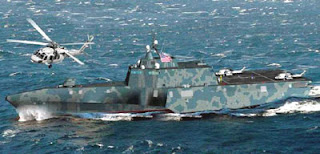
CDR Salamander's Maritime Strategy Monday: the Revolt of the Commanders ought to stir up discussion - though I am not sure how many "flag bound" O-6s are reading blogs critical of the group think that has put us where we are. I do know that when on exercises it was common to acknowledge that some issues were "too hard" or "too time consuming" to let them dominate the exercise, though in real life one will not be able to "assume away" such problems.
In my view, during my last days being involved with such matters, we were not training senior officers in how to fight and how hard that fighting is against a determined enemy who has had time to build forces designed to exploit your well-known weaknesses.
So when CDR S calls for a "commander's revolt" I understand his frustration. And note that John Boyd paid for his revolution heavily while lesser men gained from his insight. The would-be revolutionaries need to understand the risks.
These commanders need some political help from someone who understands that we shouldn't have billion dollar ships doing missions poorly that could be done better by having many more mission-designed ships. To use a famous Navy phrase, "any ship can be a mine sweeper once." Real minesweepers can be reused after they have swept a channel- multi-billion dollar "capital ships" cannot.
Given the promise of "network centric warfare," merely connecting a few huge platforms under-utilizes the potential for linking many small ships for greater tactical flexibility. Or, as Captain Wayne Hughes writes in Fleet Tactics and Coastal Combat (p.286):
We have seen that the number of ships is the most valuable attribute that a fleet can have. We also saw that many small ships offer more tactical flexibility... The U.S. Navy is composed of large, highly capable ships, many of which have area defense capability. It was for defense more than for offense that the American navy sacrificed numbers for quality.*The asterisk is to his footnote:
Another reason is because of the economies of scale. A large ship with three times the displacement of a small one will have three or more times the payload and probably only cost twice as much. Sometimes the ship must be big to carry and operate its payload, modern carrier aircraft illustrate. A large ship is also more comfortable for long cruises in many kinds of weather.Hughes needs to be listened to. Sometimes the economies of scale and crew comfort need to be weighed against other factors, like winning wars and not being afraid to send your expensive ships into harm's way.
Someone needs to stand up and tell Congress that nuclear power is not the answer for all of our ships...("That Emperor has no clothes" ). The idea of a nuclear powered LCS (or "Street Fighter") is laughable. I can imagine the small area of the world's oceans where such expensive ships will be allowed to operate least some non-state agency like Hezzbollah fire a "rocket in a box" and sink a nuclear ship off some coast while the environmentalists raise the flag of defeat so that some spiny sea plankton doesn't suffer the possibility of radiation danger. Bring on the revolt!
Speaking of littoral nations and nuclear powered ships, Chap linked to this:
THE region is at a serious risk of a major catastrophe due to military nuclear-powered and armed ships and submarines entering Gulf waters, an expert warned yesterday.The vessels "come and go as they please" with no one to monitor them, said Regional Organisation for the Protection of the Marine Environment executive secretary Dr Abdulrehman Al Awadhi.The Gulf in question is the Arabian/Persian Gulf. And so it begins...
"If there is a radiation leak in any of these vessels, it would spell disaster for the area," Dr Al Awadhi told the GDN.
"When the ship is in port or even in the waters off port, by the time anything could be done, it would be too late."
UPDATE: Galrahn sees "motherships".
UPDATE2: Re nuclear power for DDGs.

No comments:
Post a Comment